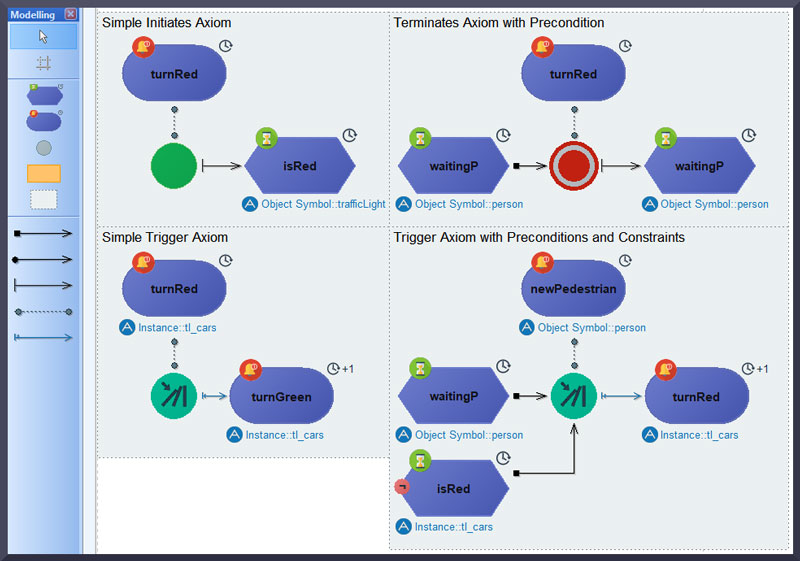by Nena Basina, Theodore Patkos, Dimitris Plexousakis (FORTH-ICS)
Reasoning about actions, change and causality constitutes an important field of research in artificial intelligence. A visual representation of the main concepts involved while encoding logic programs can help knowledge engineers better understand the semantics. The ECAVI modelling tool aims to acquaint inexperienced modellers with the main features of common sense reasoning, guiding them during the process, through a meta-modelling platform and with the help of a state-of-the-art reasoner.
Action languages are well-established logical theories for reasoning about the dynamics of changing worlds. One of the most prominent, widely-applied action languages is the Event Calculus (EC), which incorporates useful features for representing causal and narrative information. EC implementations can be encoded in different languages, such as Answer Set Programming (ASP), a form of knowledge representation and reasoning paradigm oriented towards solving complex combinatorial search problems. ASP programs define a set of logical rules, whose models, called answer sets, correspond to solutions to a reasoning task, such as progression or planning. However, both ASP and the EC can be quite difficult to axiomatize by the non-expert and novice practitioners find it hard to properly model a domain of interest.
Some researchers [1], [2] have argued the importance of visualisations for knowledge engineers. In the context of EC, we argue that a visual representation of the various axiom types may help knowledge engineers understand the semantics of the different axiom types, thereby simplifying the learning process for inexperienced modellers and reducing the number of modelling mistakes.
To this end, we are developing a domain-independent tool, ECAVI (Event Calculus Analysis and Visualization) [L1], which offers a visual language for designing dynamic domains in the EC. ECAVI implements a translation of EC theories into ASP rules, through the ADOxx meta-modelling platform and with the help of the state-of-the-art automated Clingo ASP reasoner.
ECAVI is implemented with the use of the ADOxx meta-modelling platform [L3] where the developer can define the metamodel and the modelling method for the created toolkit. Following the framework for the description of modelling methods proposed by Karagiannis and Kühn [3], we developed a modelling language that is tailored to the Event Calculus way of representing causal relations. The ADOxx platform comprises two components: the Development Toolkit, which we use to build the modelling language of the tool, and define its graphical representation; and the Modelling Toolkit, where the end user designs a domain of application that will be translated into an ASP program. The program is then sent to the Clingo ASP reasoner [L2] to produce the results. The AdoScript macro language of ADOxx is the actual link between ADOxx and Clingo, while a Java program is used as an intermediate for translating the designed models into ASP and vice versa. To accommodate the modelling process, we follow a common practice in knowledge engineering for dynamic domains, which breaks down the modelling tasks into four sub-models, separating the “alphabet” from the domain axiomatization.
We also use AdoScript to implement a number of features that assist the user during the process of building an axiom, to support a number of integrity checks and for implementing simple, yet fundamental checks for syntactical errors. In the future, we aim to implement some extensive meta-reasoning into ECAVI that will help more experienced users better run and visualise their programs.
The target group of ECAVI is novice knowledge engineers, with little or no knowledge of the EC formalism. To facilitate the use of the tool, a tutorial has been implemented, using traffic lights as a sample use case, as part of a general-purpose smart city scenario. The tutorial is in the form of a walk-through wizard, which guides the user step-by-step through the process of defining the domain of interest. A snapshot of the axioms that define the use case is shown in Figure 1.

Figure 1: A sample of the axioms defined for the traffic light paradigm.
Overall, ECAVI aims to offer a visual language for designing causal dynamic domains, achieving a tight coupling of the visual domain representation with two powerful logical formalisms, namely the EC and ASP, while also assisting the user in the process of knowledge engineering, minimising the syntactical errors and helping with logical fallacies. And most importantly, ECAVI adopts a pedagogical approach and aims to help the non-expert learn the basics of how a conceptual model can be translated and executed through the logic programming paradigm.
ECAVI will be extended in the future. We are currently working on evaluating the tool’s usability in terms of satisfaction, efficiency and effectiveness. Upcoming versions will consider more features such as non-determinism, indirect effects of events, causal constraints, etc. Furthermore, we plan to extend our focus to other types of users, with different levels of modelling experience. As more experienced users have different needs, new features will have to be supported, which may be useful for modelling large domains with complex rules. In the long run, we envision ECAVI to take the form of a fully visual integrated development environment for modelling dynamic domains, complemented with a debugger, step-by-step execution and other features typically found in IDEs.
Links:
[L1] https://nenabas.github.io/ECAVI_release/
[L2] https://potassco.org/
[L3] https://www.adoxx.org/live/introduction-to-adoxx
References:
[1] R. Morgan, G. Grossmann, M. Stumptner: “VizDSL: Towards a Graphical Visualisation Language for Enterprise Systems Interoperability”, 2017 International Symposium on Big Data Visual Analytics (BDVA), 1–8, 2017
[2] H-G Fill, D. Karagiannis: “On the conceptualisation of modelling methods using the ADOxx meta modelling platform”, Enterprise Modelling and Information Systems Architectures, 8:4-25, 2013.
[3] D. Karagiannis, H. Kühn: “Metamodelling platforms”, in Proc. of EC-WEB '02, pp. 182-, Springer-Verlag, 2002.
Please contact:
Nena Basina , FORTH-ICS, Greece











